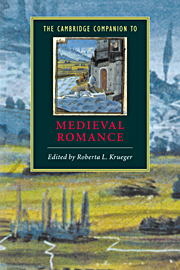Book contents
- Frontmatter
- Introduction
- Part 1 The origins, forms, and contexts of medieval romance
- 1 The shape of romance in medieval France
- 2 Marvels of translation and crises of transition in the romances of Antiquity
- 3 Romance and other genres
- 4 The manuscript context of medieval romance
- Part 2 European romance and medieval society
- Part 3 European transformations
- Editions and translations
- Index
- Series list
2 - Marvels of translation and crises of transition in the romances of Antiquity
from Part 1 - The origins, forms, and contexts of medieval romance
Published online by Cambridge University Press: 28 May 2006
- Frontmatter
- Introduction
- Part 1 The origins, forms, and contexts of medieval romance
- 1 The shape of romance in medieval France
- 2 Marvels of translation and crises of transition in the romances of Antiquity
- 3 Romance and other genres
- 4 The manuscript context of medieval romance
- Part 2 European romance and medieval society
- Part 3 European transformations
- Editions and translations
- Index
- Series list
Summary
Alexander the Great approaches the beautiful and rich Queen Candace. He is disguised as his own messenger, and travels under the protection of Candace’s son. Long ago she had sent Alexander letters offering both her realm and her love, but only if he would take her as his equal (“si a pier la volt avoir”). Since then he has heard a prophecy of his approaching death and has defeated his last great enemy, the emperor Porrus of India, but now he puts aside both militancy and impending mortality. Candace awaits, gorgeously dressed, attended by minstrels,
E se fist vieler e harper un nouvel son
Coment danz Eneas ama dame Didon,
E coment s’en ala par mer od son dromon,
Cum ele s’en pleint sus as estres en son,
E cum au de roin se art en sa meson.
Pensive en est Candace del torn de la chançon.
Es vous donc son fiz! Candeules ot non,
E tient par le poing destre son noble compaignon.
And she had them playing on viol and harp a new tune
How lord Eneas loved lady Dido,
And how he went off to sea in his swift galley,
How she cried her lament up to the rooftop,
And how at last she burned herself in her palace.
Candace was pensive at the close of that song,
When behold! Here’s her son, Candeules was his name,
Holding his noble companion by the right hand.
(Roman de Toute Chevalerie, 7650–57)- Type
- Chapter
- Information
- The Cambridge Companion to Medieval Romance , pp. 29 - 44Publisher: Cambridge University PressPrint publication year: 2000
- 11
- Cited by



